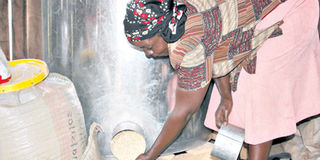We’ve defeated Osama with simple silos

A farmer removes maize from the silo in Nakuru . Farmers have been challenged to use the East Africa Community (EAC) market to sell maize, instead of calling for an end to imports. FILE PHOTO | NATION MEDIA GROUP
What you need to know:
- Having invested in the new technology, Wamwangi expects to sell his 10 bags of maize this time round for at least Sh3,200 per bag in the coming months.
- Maize, according to Muraya, is supposed to have not more than 13 per cent moisture context before being put in the silo.
- The farmers buy the metal silo, which costs Sh18,000, in groups.
The name Osama normally sends shivers down the spines of many cereals farmers. But it is not Osama bin Laden, the terrorism kingpin killed in Pakistan in 2011.
For the farmers across the country, Osama refers to a deadly weevil that can decimate thousands of bags of maize or beans in a short period.
They nicknamed the weevil known as Larger Grain Borer Osama because of its harmful effects.
Farmers in Wanyororo, Bahati sub-county, Nakuru are among the worst hit by the weevil. Osama started terrorising them about three years ago. To avoid losses, they would sell their produce soon after harvesting.
But that is all in the past. Today, the farmers have found a new gadget that enables them to conserve their maize and beans without even adding pesticides.
The gadget dubbed Metal Silo is cylindrical and was designed by Catholic Diocese of Nakuru (CDN).
“It enables farmers to store their maize as long as they wish after harvesting. They can, therefore, not worry about weevils, rats and other destructive pests,” said John Muraya, agricultural programmes officer with CDN.
The farmers buy the metal silo, which costs Sh18,000, in groups.
“We first started with each farmer contributing Sh3,000 for registration with CDN. One must be in a group of at least 10 farmers. Those are CDN conditions,” said Florence Kamonjo, a member of Karucua Farmers Group, whose home is being used as a demonstration centre to showcase the effectiveness of the storage method.
Thereafter, each of them paid Sh1,250 for 12 months to have completed the total cost of Sh18,000 at which point CDN sells the silo. However, one can pay in cash at once.
When the Seeds of Gold team visited her home, Kamonjo was happy, with her maize having remained clean, uninfected and with no chemicals.
“The metal silo ensures there is no oxygen or moisture in it to avoid decomposition of maize, which leads to pests,” explained Muraya.
To use the gadget, one puts the grains inside. One then places a lit candle in the silo and covers the lid. Immediately all oxygen burns, the candle goes off.
Farmers fetch the produce from the gadget that should be placed on a raised platform from an outlet at the base.
Maize, according to Muraya, is supposed to have not more than 13 per cent moisture context before being put in the silo.
The officer says the metal silos have great advantages. “They take up very small space compared to gunny bags. The silos occupy a space that can accommodate two bags of maize, yet store maize that fits in 10 bags,” said Muraya.
Farmers growing other cereals like rice and wheat can also use the method of preservation to not only curb post-harvest losses, but also ensure convenience and save space.
Since CDN came up with the technology in December last year, they have sold 64 silos to farmers mostly in Nakuru County.
Before releasing the silos to farmers, CDN sought approval from Kenya Agricultural Research Institute, according to Muraya.
“I have so far preserved 10 bags of maize in my silo without using any chemicals,” said Wallece Wamwangi, a farmer.
Last year, Wamwangi had to sell his 12 bags at Sh1,800 in February having harvested in December to avoid losses.
Sh3,200 A BAG
Having invested in the new technology, Wamwangi expects to sell his 10 bags of maize this time round for at least Sh3,200 per bag in the coming months.
“That means I would have made Sh1,400 per bag compared to what I did last year yet I did not buy pesticides,” said Wamwangi
Kenya Agricultural Research Institute (Kari) senior researcher Paddy Liahayo says the Metal Silo works by ensuring the level of oxygen within the tank is not more than 10 percent.
He adds that farmers need to raise their silos by placing them on wooden pallets.
“Raising the pallets is necessary as it ensures the silos do not get into contact with moisture, which can cause the metal to rust. Rusting would not only damage the silos, but also make room for oxygen entry thus, creating a conducive environment for insects’ survival.”
Though farmers can raise their silos at a low level depending on availability of space in their stores, Liahayo recommended that they should be placed one metre high.
The tanks come in different sizes. The one in the market currently holds 900kg of maize or beans, which is an equivalent of 10 bags.
However, there are others that carry five, eight, 20 and 30 bags, with the biggest going for Sh35,000.
Muraya said the technology was introduced to CDN by International Maize and Wheat Improvement Centre (CIMMYT), a Mexico-based NGO. CIMMYT paid half the cost for the first 30 farmers.
CIMMYT, he added, also funded Kari to research on the technology as it had to confirm it before CDN would start selling the silos.





